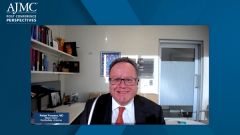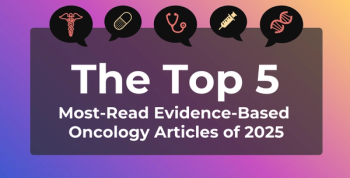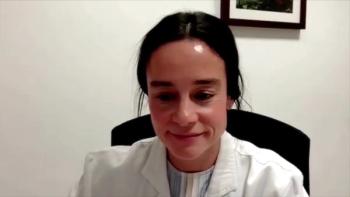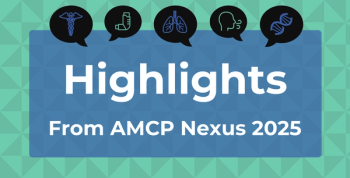
Multiple Myeloma: Current Approaches to Frontline Therapy
Taking into account data from the ASH 2021 annual meeting, Rafael Fonseca, MD, reviews his current approaches to frontline therapy for patients with multiple myeloma.
Episodes in this series

Transcript:
Rafael Fonseca, MD: With the expansion of all the drugs being proposed for frontline therapy of myeloma, it’s difficult to come to some consensus for the best recommendations. Let me start with transplant-eligible patients. In my mind, choosing the regimen that can produce the deepest level of response and to do so safely is of paramount importance. In my clinical practice, I’ve moved from the use of bortezomib [Velcade] up front.
We recently had a very important phase 3 trial, a Juno [Therapeutics] study that compares bortezomib vs carfilzomib [Kyprolis] with similar outcomes. There are some limitations to that study, but it clearly shows that there was no difference in progression-free survival. There might be some improvement under certain conditions for the use of carfilzomib. But even if you didn’t, you find that there’s going to be an exchange of toxicities. On the 1 hand, bortezomib is going to be associated with peripheral neuropathy. On the other hand, there’s the cardio renal toxicity that can happen with carfilzomib. Sometimes it can be mild, like hypertension, but sometimes can be more serious, such as decreased ejection fraction heart failure.
As we’ve learned more about this, we know that this is something that for the most part is reversible. I always argue that my clinical practice is full of patients who received the bortezomib combination for first line and are dealing years later because of the improved outcomes with the consequences of peripheral neuropathy. Certainly, you see fewer patients with chronic complications from the cardio renal toxicity. Of course, 1 must be judicious and careful in making sure you choose this treatment for the right patient. For that reason, my practice has shifted to using carfilzomib as part of this combination for the transplant-eligible patient.
As far as using 3 drugs vs 4 drugs, we saw data at ASH [American Society of Hematology Annual Meeting] that I’ll discuss with you, including from the GRIFFIN trial and the MASTER trial that suggest that adding a monoclonal antibody becomes important in deepening the response we’re able to achieve on our patients. If we get support from our peers, I prefer a combination of daratumumab, carfilzomib, lenalidomide, and dexamethasone. The real conundrum comes when you have to decide vs daratumumab–VRd [bortezomib, lenalidomide, dexamethasone] vs KRd [carfilzomib, lenalidomide, dexamethasone]. I’ve erred on the side of more KRd [carfilzomib, lenalidomide, dexamethasone] for the aforementioned reasons.
I recommend patients go on to receive a frontline autologous stem cell transplant. The future of treatment of myeloma maybe without transplant, but for now, we’ve seen with the IFM 2009 study that…the transplant allows for deeper and more durable responses. Certainly, I consider the use of consolidation and maintenance therapy after the stem cell transplant.
For patients who are transplant ineligible because of the results that I’ve seen and because of the safety provided by having a bortezomib-free regimen, I recommend the combination of daratumumab, lenalidomide, and dexamethasone. One important logical question is what to do in patients who have high-risk disease. For that, I think about 2 things. First, patients who are in the more advanced ages when they’re diagnosed with multiple myeloma are less likely to have high-risk disease. That’s important. That’s probably more in the range of 10% to 15%, but if 1 looks at the very young population, that can be 30% of patients, perhaps even more.
No. 2, this notion that the use of proteasome inhibitors [PIs] was important for patients with high-risk disease was derived from the observations that compared the use of proteasome inhibitors with IMiDs [immunomodulatory imide drugs]. Often, IMiDs are alone or in combination with dexamethasone. Some studies even include drugs like thalidomide.
Something that doesn’t make sense is the PIs were working against the FRIM biology so they would be effective against 17p allelic patients and might be effective against 4;14. Undoubtedly, we saw significant improvement in those subsets. But is it that PIs are better against high-risk disease? This is conjecture, but my hypothesis is that IMiDs single agent or with dexamethasone are insufficient for high-risk multiple myeloma. We have indirect evidence for this. We’ve seen data presented. There’s meta-analysis for daratumumab, there are data that have emerged for isatuximab, and there’s the story that it’s been billed for chromosome 1. Also, we’ve seen that selinexor [Xpovio] shows activity against chromosome 17 and the lesions. Perhaps it’s a better drug that will result in better outcomes for patients with high-risk disease, and 1 should not use IMiDs alone in this patient population.
Transcript edited for clarity.
Newsletter
Stay ahead of policy, cost, and value—subscribe to AJMC for expert insights at the intersection of clinical care and health economics.










